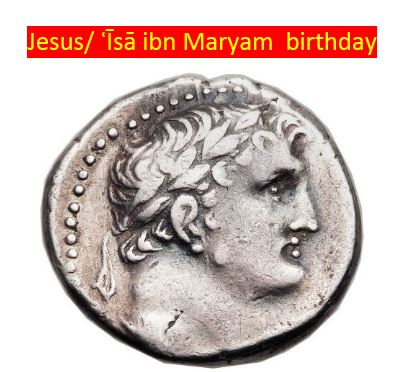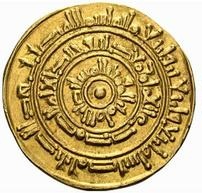

لقد فصل الله تعالى في خلق عيسى عليه السلام وأكتفي بقول الله تعالى بسم الله الرحمن الرحيم
قال تعالى في سورة آل عمران: إِنَّ مَثَلَ عِيسَى عِندَ اللّهِ كَمَثَلِ آدَمَ خَلَقَهُ مِن تُرَابٍ ثِمَّ قَالَ لَهُ كُن فَيَكُونُ
وفورا أخرج من موضوع الخلق وانتقل الى ما يهمني الى أمكانيه الوصول الى تحديد مولده او ما يقاربه ان شاء الله بحسب النقود التي نجدها - سيقول البعض فكيف لك من النقود ان تحدد تاريخه وقد تكون نقود تاريخيه تم تزويرها ..
نرد فورا بأن الثوريين بالفتره الامويه لعبوا بالدراهم وغيروا فيها وباثوراتها ولكنهم أبدا لم يغيروا في التاريخ الحالي الا بأخطاء السك وايضا ظهرت بالنقود االشرعيه التي كانت تخرج من دور السك .
وانا اعتبر ان النقود والكتابات على النقود / الصخور او النحاسيات هي اصدق من اي مؤرخ ومن اي كتاب قبل القرآن وتعتبر النقود كما أعنونها في منتداي انها الوثيقه الاخلاقيه الوحيده التي تحديثنا عن تاريخ صلب مكتوب ومرسوم بحروف مرقومه .
ما نشاهده امامنا هو موضوع كبير ويغفل عنه الجميع من الشيوخ والكهنه وضرب من هده النقود بالملايين تحميل ترتيب أخلاقي للتاريخ المدني الذي كان سائدا وبقيت هدا النقود تضرب من بين 130-126 قبل الميلاد الى حتى 66 ميلادي مبدئيا على هدا الطرتز وبعدها ظهرت افلاس له في عهد دومتيان وترجان وهدا ميلاديا ( يعني هده النقود بقيت تضرب حتى العهد الروماني ولكن بطراز اخر بعد 65 ميلادي )
ما يهمنا هو الفتره ما قبل الميلاديه ونبدا ان شاء الله . ونقول ان هده النقود ( شيكل ) تعود الى اله صور الملك ( ملقرت ) فنيقيه العهد وكان يتم ضربها او انتاجها على سواحل صور ولذلك نسميها (تير ) اي صور (tyre) وهي مدينة ساحليه لبنانيه من أشهر المدن التي تم ذكرها في التاريخ الفنيقي وضرب لها الفنيقيون والرومان والاغريق والمسلمون أجمع وسيكون لها الحظ الاوفر مع مدينة صيدا في كتابي ان شاء الله ولكن ما زلت في طور البحث على دار نشر . ولكن الشخصيه التي تظهر على العمله هي ليست لهرقل ممثله بملقرت ووزنها يختلف بين الدرخما وتترادرخما 7 الى 14 غرام
لم نشاهد الى الان اي نقود له مسجل به شها في الجه الذي تحتويه الشخصيه . ما تم تدوينه بالكتابه اليونانيه على الوجه الثاني للنسر ودون حوله النشر اي في الطوق TYPOY IEPAΣ KAI AΣYΛOY اي المجد والعزه لصور .. والنسر هو موروث يرمز الى القوه والحكمه . وفش ايضا التاريخ المدني عليه وعلى توشيحات اخرى قد نحتاجها لحديد المدينة . ولن ادخل بكيفيه استخراج التاريخ حتى لا نترك للمزورين بابا يدخلون منه. وايضا سجل فيها حرفين يونانين على ظهر النسر KP ايضا نتحفظ على تفسيرهم وايضا KPC/S ونقول فنيقي لان هناك حروف فنيقيه تظهر فيه زايضا بسبب مدينة صور كانت الرمز الفنيقي الاول وذكرها كل من الملك تبنيت واشمون عازار وعبد اشترتي وملك قرطاجه يهمليك وغيره تحت اسم ( تير ) وصيدا تحت اسم الجمع صندم SDNM والمفرد صيدا SDN
ويمكن تحديد تاريخ هده القطعه تقريبا مدنيا 126 ما تعادل ( 1 ميلادي ) اليوم الذي ولد فيه المسيح عليه السلام . يعني تقويم تحديدا السنه الميلاديه الاولى بين شهر 7 الى 9 بفتره يكون البلح ناضجا تصديقا في قول الله تعالى بسم الله
﴿وَهُزِّي إِلَيْكِ بِجِذْعِ النَّخْلَةِ تُسَاقِطْ عَلَيْكِ رُطَباً جَنِيّاً * فَكُلِي وَاشْرَبِي وَقَرِّي عَيْناً فَإِمَّا تَرَيِنَّ مِنَ الْبَشَرِ أَحَداً فَقُولِي إِنِّي نَذَرْتُ لِلرَّحْمَنِ صَوْماً فَلَنْ أُكَلِّمَ الْيَوْمَ إِنْسِيّاً﴾. [ سورة مريم الآية: 25-26].
ونشاهد ايضا فوق النسر احدى اغصان البلح وصور من اكثر البلاد الساحليه غنيه ببساتين البلح الى الان .
فهدا الضرب تم انتاجه بمولد المسيح عيسى ابن مريم وفي عهده بقيت هده النقود تضرب وتم استعمالها في عهده وقيل انها من احدى النقود التي تم استعمالها لرشي تلامذه المسيح والهم في قتله .
This dating system is based on the calculations of Dionysius Exeguus in about AD 525; however, modern scholars have concluded that Jesus was actually born a few years earlier, probably 5-4 BC. Establishing the actual lifespan of Jesus is thus an uncertain exercise at best, as the Gospel accounts contain no detailed time line and the actual dates that are mentioned are frequently contradictory
However it is possible to set the broad goalposts between which Jesus must have lived, using the earliest widely accepted year for his birth, 5/4 BC, and the latest likely date for his Crucifixion, AD 33/4. Three of the Gospels state Jesus was born in Bethlehem, about 10 kilometers from Jerusalem; his earthly parents, however, were from Nazareth in Galilee and evidently this is what he considered his "hometown." Here he grew to manhood and embarked upon his epochal ministry at about the age of 30, likely sometime between AD 24-30. The Gospel of Luke mentions that John the Baptist's ministry in the wilderness began in the "fifteenth year of Tiberius Caesar (or AD 28/9)." Since Jesus was baptized by John, it is likely his own two or three-year ministry began after this. Equal uncertainly surrounds the date of the Crucifixion. All the Gospels and the historian Josephus record that Jesus was executed by Pontius Pilate, the Roman governor (or prefect) of Judaea AD 26-36, and that he was crucified on a Friday before the Feast of Passover. The most widely accepted dates for the Crucifixion are 18 March AD 29, 7 April AD 30, and 3 April AD 33. Shekels of Tyre: The Phoenician port city of Tyre rose to prominence in the tenth century BC as an international trade center, becoming wealthy from its export of a deep purple dye made from a mollusk, the famous "Tyrian purple" worn by royalty. It maintained good relations with the Kingdom of Israel and even helped finance the construction of Solomon's temple circa 971-931 BC. It became a Persian vassal in 539 BC and, after a legendary siege, fell to Alexander the Great in 332 BC. Tyre was fought over by the successor Ptolemaic and Seleucid Kingdoms for another two centuries before finally regaining its independence in 126 BC
From this year, Tyre began issuing silver coins, shekels and half-shekels, that were widely accepted in the Levant as a trade currency due to their carefully controlled weight and fineness. Tyrian shekels carry the obverse image of Melqart, a Phoenician version of Heracles, and a reverse depiction of an eagle standing left on the prow of a ship, palm branch tucked under its right wing, with a club (of Melqart / Heracles) in the left field. The reverse legend translates to "Of the Holy and Inviolable City of Tyre" and in the left field is a date in Greek numerals, counting years forward from the date of the city's autonomy (126/5 BC). Other letters and monograms identify the responsible mint magistrates; a Phoenician letter aleph or bet between the eagle's legs most probably indicate the office or workshop where the coin was struck. Lacking a silver currency of its own, the newly independent kingdom of Judaea came to accept the use of Tyrian silver as the main coin of the realm. Tyrian shekels and half-shekels were the only coins acceptable as tithes and payments to the Temple in Jerusalem, which was vastly expanded by Herod the Great (37-4 BC). This situation maintained after the Romans gained direct control of Judaea after Herod's death. After 20/19 BC, the style and fabric of Tyrian coinage changed markedly, with the coins becoming smaller and thicker, and the letters KP were added to the reverse control marks. The noted Israeli numismatist Ya'akov Meshorer proposed that these later shekels were actually minted in Jerusalem rather than Tyre, based on hoard evidence that the coins circulated far more heavily Judaea than in neighboring Phoenicia. While this view is not widely accepted, it is clear these later shekels were minted primarily to meet burgeoning demand in Judaea and surrounding regions. Edward Cohen, author of "Dated Coins of Antiquity,"
notes that the date form of the later shekels (consistently reading left-to-right) differs from the earlier issues and indicates a different mint in the southern Levant. These "KP" shekels were evidently minted more sporadically, and in smaller numbers, than earlier issues and are generally much rarer today; in fact coins are unknown for several of the years between 20 BC and AD 66, when their issue ceased. Other years are known from only a single specimen or a handful of examples. The Tyrian shekel features prominently in many Gospel accounts, most notably the scene in which the Apostle Judas betrays Jesus to the Temple authorities and is "covenanted" with "30 pieces of silver." These were certainly shekels of Tyre. In another scene (Matthew 17:24-27), Jesus plucks a shekel from the mouth of a fish to pay his Temple tax. The famous incident where Jesus attacks the "money changers" in the Temple courtyard likely resulted in many Tyrian shekels flying about, as this was the currency into which visitors were changing their own native coin




















